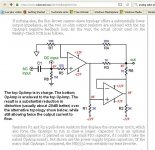The original BB application note I'm guessing is the one on p273 in this compilation. Worth a read. But is it necessary? Depends what you're driving, I suppose.
https://www.google.com/url?sa=t&sou...FjAAegQIBBAB&usg=AOvVaw3RjNhxjPA7nNbffRC820WL
https://www.google.com/url?sa=t&sou...FjAAegQIBBAB&usg=AOvVaw3RjNhxjPA7nNbffRC820WL

I cannot see this making a difference in a line stage where there is hardly any current passing through the load.
Has been used in headphone amplifiers for ages, see "apheared-47" amp.
Pros: Doubled output current, low output impedance.
Cons: Needs a noise gain of at least about 3 to be stable. (A small cap from "master" opamp out to -in may be beneficial in this regard.) Only moderate benefit in distortion as "master" opamp still sees significant output loading. (Circuit shown in first post "cheats" by employing output Class A biasing as well.) If memory serves you can trade off output current / distortion / stability by varying splitter resistor values... will have to drag out my sim.
It's basically the "el cheapo" version of using a proper high-speed power buffer (either discrete follower or BUF634 and the like).
I could see it potentially being useful when you're trying to wring out the best dynamic range from some inexpensive low-noise opamps with so-so output driving like NJM2068, which normally are not too happy driving feedback network impedances below ~2 kOhm at high levels. But as stated, if you can afford going full power buffer that'll probably be better.
Also see Technics "Class AA" circuit.
Pros: Doubled output current, low output impedance.
Cons: Needs a noise gain of at least about 3 to be stable. (A small cap from "master" opamp out to -in may be beneficial in this regard.) Only moderate benefit in distortion as "master" opamp still sees significant output loading. (Circuit shown in first post "cheats" by employing output Class A biasing as well.) If memory serves you can trade off output current / distortion / stability by varying splitter resistor values... will have to drag out my sim.
It's basically the "el cheapo" version of using a proper high-speed power buffer (either discrete follower or BUF634 and the like).
I could see it potentially being useful when you're trying to wring out the best dynamic range from some inexpensive low-noise opamps with so-so output driving like NJM2068, which normally are not too happy driving feedback network impedances below ~2 kOhm at high levels. But as stated, if you can afford going full power buffer that'll probably be better.
Also see Technics "Class AA" circuit.
Last edited:
